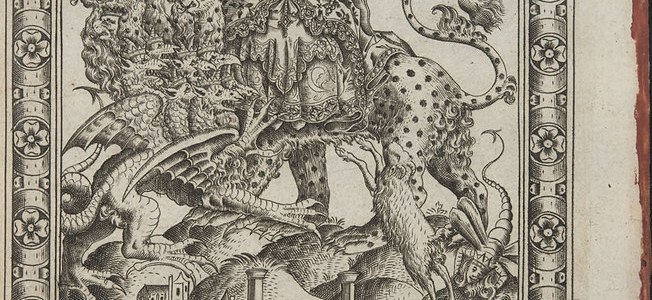Hot on the heels of my post on the air ships of medieval Ireland, Rich Reynolds at UFO Conjectures offered some, well, conjectures of his own concerning two sixteenth century broadsheets introduced to ufological consciousness by Carl Jung in his famous book on Flying Saucers.
The first is from Nuremberg in 1561 by Hans Glaser:

The second is from Basel, 1566, by Samuel Coccius.

Reynolds and I agree on dismissing out of hand the all-too-common Ancient Astronaut / Alien theoretical interpretation that sees these as premodern UFO sighting reports. Reynolds, however, goes a step farther, somewhat along the lines I pursue with regard to the medieval Irish airship tales, positing that these broadsheets’ illustrations are, in his words, “editorial cartoons” concerning the religious strife that was dividing post-Reformation Europe at the time. Interested readers can follow our dispute on this matter at the link to UFO Conjectures, above.
I maintain, maybe surprisingly, that the broadsheets are reports of real, if mysterious, occurrences. I base that claim on two main features of the broadsheets. First, both illustrations relate to the text they accompany, stories of anomalous aerial phenomena. These stories are, furthermore, specific as to date and time of day, which they wouldn’t be were they satirical allegories of current affairs. (They would, moreover, likelier be in verse, as was the convention of the time).
Reynolds takes exception, especially with regard to the Nuremberg broadsheet (the first of those reproduced, above), pointing to the smoke billowing in the lower right hand corner (which he sees as “the wrath of God, afflicting either Luther’s heresy or the Church’s vivid rebuttal”) and the prominent black spearhead that points to the left over the city (“A spear? Or some kind of Germanic weather icon…?”).
Reynolds is mistaken on two counts, I argue. First, the text that accompanies the picture that illustrates it refers to “globes, which were first in the sun” and that
flew back and forth among themselves and fought vehemently with each other for over an hour. And when the conflict in and again out of the sun was most intense, they became fatigued to such an extent that they all, as said above, fell from the sun down upon the earth ‘as if they all burned’ and they then wasted away on the earth with immense smoke. [my emphasis]
The text continues: “After all this there was something like a black spear, very long and thick, sighted; the shaft pointed to the east, the point pointed west” [my emphasis]. So, it isn’t difficult to relate what the text refers to and what the illustration depicts. More seriously, Reynolds resists the highly stylized artistic conventions of the illustration, ignoring, for example, a striking evidence for this in the sun’s having a face, let alone how the picture neglects perspective.
So, the context of the illustration (the details of its accompanying text) and the artistic conventions of the day both contradict Reynolds’ attempt to write off the picture (he never gets around to the text) as allegorical treatments of the times and support the contention that they are illustrated reports of actual events.
But Reynolds is right when the historical context of religious strife moves him to see things the way does. Hans Glaser himself offers the following gloss:
Although we have seen, shortly one after another, many kinds of signs on the heaven, which are sent to us by the almighty God, to bring us to repentance, we still are, unfortunately, so ungrateful that we despise such high signs and miracles of God. Or we speak of them with ridicule and discard them to the wind, in order that God may send us a frightening punishment on account of our ungratefulness. After all, the God-fearing will by no means discard these signs, but will take it to heart as a warning of their merciful Father in heaven, will mend their lives and faithfully beg God, that He may avert His wrath, including the well-deserved punishment, on us, so that we may temporarily here and perpetually there, live as his children. For it, may God grant us his help, Amen.
Clearly, Glaser understands whatever in fact is described in the text as signs from heaven, and he does so precisely because of the concrete historical situation that determines his writing and illustrating the broadsheet.
Not only does Reynolds abstract the illustration from the immediate context of its accompanying text, however, but he (mis)understands the illustration, viewing it through conventions of visual representation foreign to Glaser’s time and place. He’s right to find inspiration for his interpretation in the historical situation, but neglects another dimension of that context.
Jerome Clark in The UFO Book: Encyclopedia of the Extraterrestrial (1998) in the entry for “Anomalous Aerial Phenomena Before 1800” (44-58) remarks the tremendous appetite for books of prodigies and wonders in the sixteenth and seventeenth centuries, including the following telling tidbit: “Rediscovery of the prodigy book of Osequens in 1508 set off a flood of similar works. The most comprehensive was the Prodigiorum ac Ostentorum Chronicon of Conrad Lycosthenes, which appeared in 1557 at Basel” (48) [my emphasis]. The broadsheets then are most likely best taken to be examples of this genre, catering to the public appetite for news of wonders.
What’s important here is not Reynolds’ and my dispute, but the kind of thinking at work in understanding historically distant documents. Ironically, though we both eschew the Ancient Alien misunderstanding of these broadsheets, Reynolds’ own take is led astray by the same kinds of errors: abstracting the illustration from its immediate context and viewing it apart from the artistic conventions and discoverable material cultural interests of the time.
What then is reported and depicted by these broadsheets? Glaser, perhaps, gives the best answer: “God alone knows.”
Addendum: Reynold’s replies in his own inimitable way here.


4 thoughts on ““There is nothing outside of the context””